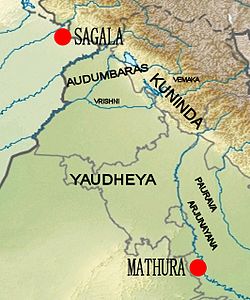

Kuninda Kingdom
| |||||||
|---|---|---|---|---|---|---|---|
| Before 2nd century BCE–3rd century | |||||||
|
Silver coin of the Kuninda Kingdom, c. 1st century BCE. These coins followed the Indo-Greek module.[1] | |||||||
| Location on the Kunindas and contemporary South Asian polities circa 150 CE.[2] | |||||||

Location of Kuninda relative to other groups: the Audumbaras, the Vemakas, the Vrishnis, the Yaudheyas, the Pauravas and the Arjunayanas.
| |||||||
| Government | Monarchy | ||||||
| History | |||||||
• Established | Before 2nd century BCE | ||||||
• Disestablished | 3rd century | ||||||
| |||||||
| Today part of | India Nepal | ||||||
The Kingdom of Kuninda (orKulinda in ancient literature) was an ancient central Himalayan kingdom documented from around the 2nd century BCE to the 3rd century, located in the southern areas of modern Himachal Pradesh and far western areas of Uttarakhand in northern India and Doti GadwallinNepal.
The first mention of kuninda appears in Panini Ashtadhyay where he mentions it as an Ayudhajivi Sangha, meaning a warrior republic. Though, the kingdom may have existed earlier as it is also mentioned in Mahabharat to be situated in the east of kuru kingdom.[3] The history of the kingdom is documented from around the 2nd century BCE. They are mentioned in Indian epics and Puranas. The Mahabharata relates they were defeated by Arjuna.
One of the first kings of the Kuninda was Amoghbhuti, who ruled in the mountainous valley of the Sutlej and Yamuna rivers (in today's southern Himachal and far western Uttarakhand in northern India).
The Greek historian Ptolemy linked the origin of the Kuninda to the country where the rivers Beas, Sutlej, Yamuna and Ganges originate.[4]
One of the Edicts of Ashoka on a pillar is also present at Kalsi, in the region of Garhwal, indicating the spread of Buddhism to the region from the 4th century BCE.
The Kuninda kingdom disappeared around the 3rd century, and from the 4th century, it seems the region shifted to Shaivite beliefs.
There are two types of Kuninda coinage, the first one issued around the 1st century BCE, and the second around the 2nd century CE. The first coins of the Kuninda were influenced by the numismatic model of their predecessor Indo-Greek kingdoms, and incorporated Buddhist and Hindu symbolism such as the triratna and images of Lakshmi. These coins typically follow the Indo-Greek weight and size standards (drachms, of about 2.14 g in weight and 19 mm in diameter), and their coins are often found together with Indo-Greek coins in hoards, such as those of the Yaudheyas, or the Audumbaras.
The finds of Kuninda coins have often been associated with finds of Indo-Greek coins, particularly those of Appolodotus.[5]
A very large portion of the Kuninda coins are in the name of king Amoghabhuti, and it is believed that coinage under his name continued after his death.[5]
Some later coins of the 2nd century CE bear the symbol of the Hindu god Shiva.[5]
|
| |||||||
|---|---|---|---|---|---|---|---|
| Topics |
| ||||||
| History |
| ||||||
| Culture |
| ||||||
| Jurisdiction |
| ||||||
| Districts and divisions |
| ||||||
| Major cities |
| ||||||
| Economy |
| ||||||
| Geography |
| ||||||
| Images and others |
| ||||||
|
| |||||||||||||||||||
|---|---|---|---|---|---|---|---|---|---|---|---|---|---|---|---|---|---|---|---|
State capitals: legislative: Dehradun (winter); Bhararisain (summer); judicial: Nainital | |||||||||||||||||||
| Government |
| ||||||||||||||||||
| History |
| ||||||||||||||||||
| Geography and ecology |
| ||||||||||||||||||
| Demographics |
| ||||||||||||||||||
| Administrative divisions |
| ||||||||||||||||||
| Politics |
| ||||||||||||||||||
| Tourism |
| ||||||||||||||||||
| Sports |
| ||||||||||||||||||
| Other topics |
| ||||||||||||||||||
| Districts |
| ||||||||||||||||||
| Major cities |
| ||||||||||||||||||